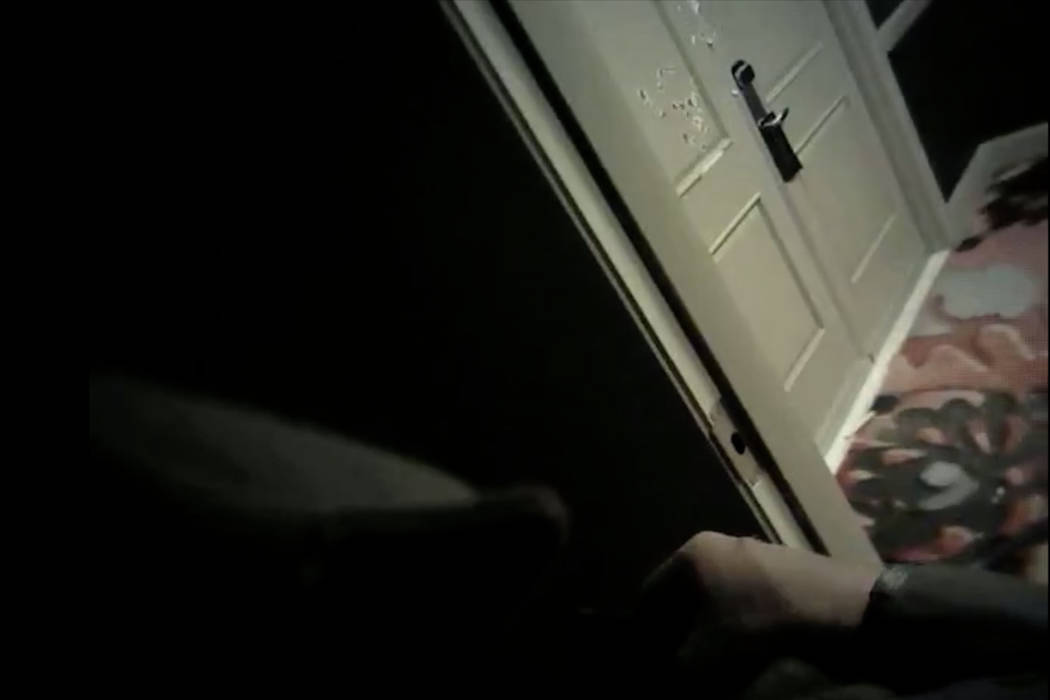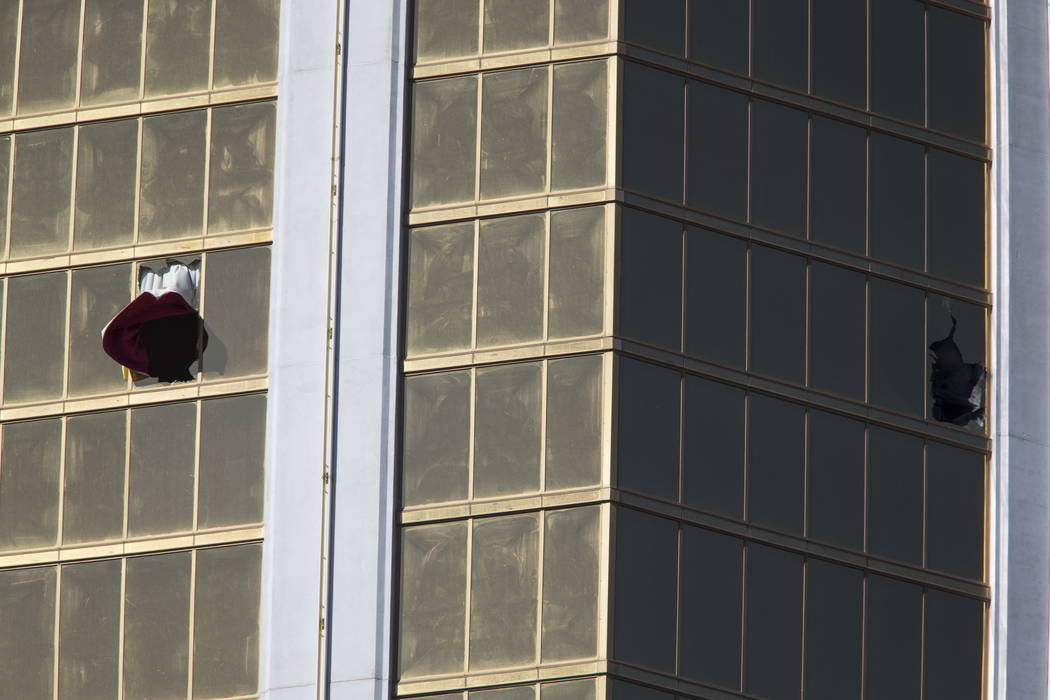Officers sneak toward Las Vegas gunman’s hotel room in new video
Newly released body camera footage from the Oct. 1 shooting shows the tense moment as two officers crept into a Mandalay Bay hallway to strap explosives to a hotel room door riddled with bullet holes.
SWAT officer Levi Hancock placed the charges while K-9 officer David Newton protected him with a ballistic shield held up in front of the door that killer Stephen Paddock had fired through earlier, wounding hotel security guard Jesus Campos.
The moment was captured by the body camera strapped to Newton’s shoulder.
Newton can be heard breathing as Hancock works. Then they retreat silently back into a nearby stairwell. The whole thing lasts less than a minute.
The footage was part of the 15th court-ordered release since early May of Metropolitan Police Department records from the attack on the Route 91 Harvest festival, which left 58 concertgoers dead and hundreds more injured.
Wednesday’s release by the department included 15 body camera videos totaling about nine hours.
‘My wife is dead’
One video from inside the festival grounds shows a man crouched over a covered body.
“My wife is dead,” he tells the officer who approaches him.
“I’m sorry,” the officer says after a few seconds, “but for your own safety, you need to get out of here.”
The man places his hand on his wife and stays where he is.
An unidentified woman steps in to comfort him, as other concertgoers drag a fence panel over, possibly to use as a makeshift stretcher to carry the dead woman out.
It’s unclear what happens next. The officer with the body camera moves on to clear more people from the area.
Another video appears to chronicle an officer keeping guard outside University Medical Center while other officers help at least two injured people out of a black sedan and into the hospital. The officer takes down contact information for the sedan’s driver and later for a man whose wife was being unloaded from an ambulance.
Footage from the top of a parking garage overlooking Park Avenue near T-Mobile Arena catches two officers with rifles comparing notes about the loved ones they had heard from that night and the ones who neglected to reach out.
“I got a text from everybody in the world except the old lady,” one of the men says.
Same view, different suite
A different video from inside Mandalay Bay shows officers in the stairwell between the 31st and 32nd floors pulling the fluorescent bulbs from the fixtures above their heads so it will be harder for a potential attacker to see them.
Moments later, as the entry team blows the door off its hinges and rushes into Paddock’s suite, an officer posted in the hallway drops to one knee and aims his rifle at the door of the adjoining room. His body camera shows a clear view of the room service cart Paddock rigged with cameras and parked outside his room. One can see the tablecloth on the cart moving in the wind that is blowing in from the two broken windows inside the suite.
Paddock had killed himself before officers entered his suite.
Earlier in Newton’s 30-minute video, he helps secure the room directly below Paddock’s, then pauses to look out at the darkened festival grounds.
A hotel security guard who is with him says the suite they’re in has the exact same layout and view as the one on the 32nd floor where the attack unfolded. “I don’t know what kind of gun is needed to break this,” the security guard says, knocking on the window overlooking the venue.
More records to come
Metro is expected to release another batch of records next Wednesday.
Police previously disclosed more than 3,000 pages of witness statements and officer reports and 911 calls and other body camera footage.
The Las Vegas Review-Journal and other media organizations sued for the records in the days after the shooting. Metro fought their release for months.
When the department was forced to comply, Metro began turning over the records in weekly batches of varying size and type. They come in no particular order, and for three months the department has refused to identify the officers whose body cameras recorded the clips. The department also has refused to confirm the exact time at which all videos were filmed.
A Review-Journal examination of the records found that many officers experienced communication problems during the mass shooting response.
Metro released its own final report on the Oct. 1 investigation in early August. Police said they were not able to determine Paddock’s motive. A separate FBI report will not be ready until sometime after the one-year anniversary, according to The Associated Press.
Contact Henry Brean at hbrean@reviewjournal.com or 702-383-0350. Follow @RefriedBrean on Twitter. Review-Journal staff writers Rachel Crosby, Natalie Bruzda, Meghin Delaney, Briana Erickson, Wade Tyler Millward, Amelia Pak-Harvey, Madelyn Reese and Mike Shoro contributed to this report.























